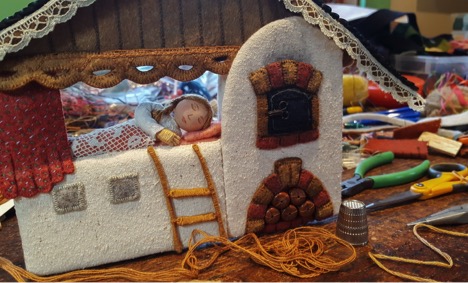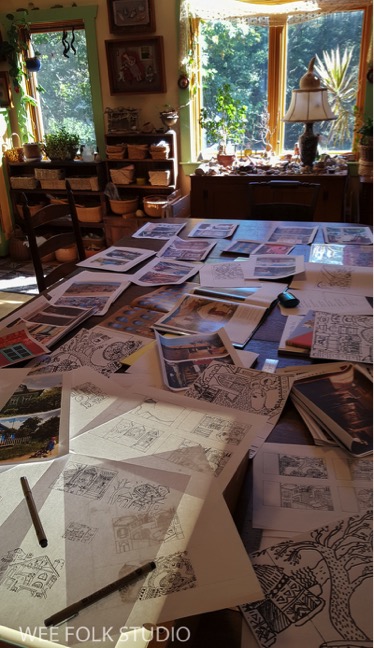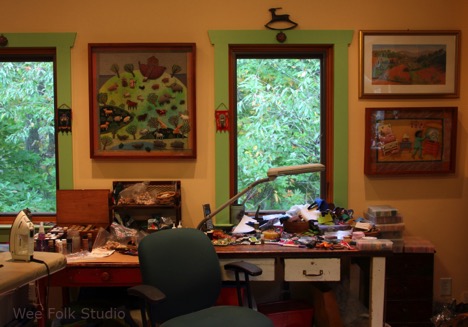When you enter Salley Mavor’s miniature world, you will meet fiber art characters who tell stories both whimsical and serious. Sometimes funny, sometimes poignant, always thought-provoking, Salley’s handmade characters invite you into their experiences.

How did you begin to use fiber as an art form? What attracted you to creating dolls?
As a child, crayons were never enough and I had the urge to sew, staple or glue real things to my pictures. My mother kept my first book; a 12 page tour of the things in an 8 year old’s life. The paper and fabric collage illustrations have held up well, including a cut out pop-up of a play kitchen. Looking back, I have early memories of sewing and constructing things at home.

My sister and I would spend hours stitching outfits and creating scenes for our dolls. I was especially interested in all things miniature and coming up with ways to decorate and furnish the dolls’ environment.

As an illustration major at the Rhode Island School of Design, I rediscovered my childhood fascination with working in 3-dimensions. My teacher recognized my interest in sewing and encouraged me to work outside of the yoke of traditional illustration mediums.
As an Amazon Associate I earn from qualifying purchases. Read more about our affiliate linking policy.

By my junior year at RISD, I had stopped trying to translate the pictures in my mind’s eye through a brush or pen. I found myself happier and energized while manipulating materials in my hands. I was no longer struggling to keep in step. With a needle and thread, I could dance. For some reason, I’d been under the impression that in art school, one concentrates on serious fine art and I’d kept my interest in handcrafts underground. I used this time in school to try different ways of working and taught myself embroidery.
Did you always know you would be an artist?
I’ve always had a keen awareness of art’s influence and presence in the world. My earliest memories involve expressing something creatively, whether it be through music, dance or visual art. My parents instilled a sense that art matters, especially my mother, who believed that making art was the reason to get up in the morning. In my mind, there was never any question that I would spend my life making things.

How did illustrating books, such as My Bed, Enchanting Ways to Fall Asleep around the World, come about?
My first children’s book, The Way Home, came out in 1991 and I’ve illustrated many more since then.

I thought the 2010 publication of Pocketful of Posies would be my last. The 3 year process of making more than 50 illustrations was so all-consuming and intense that I needed a break from the pressure of meeting deadlines. I also felt an urge to break away from the themes of childhood and explore what was happening in the adult world. I figured that if I was ever going to push myself artistically, now was the time.


So, for a number of years I worked outside of the constraints of children’s books, exploring new subject matter and tackling issues that address social and cultural connections. My new pieces were very satisfying to make; they were larger and took more time to complete than anything I’d done before. I felt more like an artist than an illustrator.

But there was something about illustrating children’s books that I missed. I like the small, intimate format and the tidy structure of a collection of pages. I also missed working within the wonderful community of children’s book publishing. And I wanted to paint children’s faces again. An editor from Houghton Mifflin must have caught me during this nostalgic moment, because she enticed me into doing another book. The multi-cultural story written by Rebecca Bond celebrates our differences, while also bringing us together through the universal theme of children sleeping in their safe little beds.
It took 2 years to make the artwork for My Bed, Enchanting Ways to Fall Asleep around the World, which will be published in Sept. 2020. Creating the illustrations for this book has been a wonderful adventure. I feel as if I’ve gotten to visit all the children in the places they live around the globe, even though I stayed home. I am excited to announce that a touring exhibition of the original bas-relief sculptural embroideries for the book will travel to museums around the country beginning in the fall of 2020.

Your work is so very labor-intensive, but that doesn’t seem to slow your pace. It appears the children in the book sleep. Do you?
Yes, making my art is very time consuming and not very practical, but that is part of what attracts me to this way of working. I sew, wrap, embroider, carve and embellish in as many ways as I can—all by hand.
What I can’t really do is speed up the process and machines are no help. In the past, I used a sewing machine, but now find that I can better achieve the look I want with hand stitching. Through the repetitive, tactile process, I find a calm satisfaction that helps lead to effective problem solving. Each piece requires figuring out something new, whether it is a way of constructing a driftwood house or making a tiny basket, so I need time to work things out.

Making art makes me happy, so I spend as much time as possible working. In fact, I work all the time. My husband Rob jokes, “When Salley is not sleeping or eating, you can find her in the studio.” I try hard to live a balanced life, meeting with friends, exercising and paying attention to my family, but really, all I think about is the project I’m currently working on or what I’m going to make next. Every successful artist I know is like this. We are driven to create.
Are there recurring themes in your work? How does that affect your approach?
For most of my 40 year career, my art reflected a comforting and bucolic existence. I also ran a business designing and selling fairy kits for 10 years. That led to writing the how-to book, Felt Wee Folk, which is how a lot of people were introduced to my dolls.

Let’s face it, my work is cute and adorable. People ask, “How do you feel about having your work called cute?” Mostly, I find the term cringe-worthy, even though I know it’s a valid description of much that I make. It’s just that the word “cute” can sound belittling and dismissive when characterizing art. But recently, I’ve experienced the power in making art that draws the viewer in, in a non-threatening way, so a message gets through. So, making cute art has its advantages.

Please introduce us to the Wee Folk Players. What is their origin story and what can we expect from them in the future?
The Wee Folk Players are a theater troupe that performs political satire in a doll house. The cast is made up of little dolls playing the parts of recognizable public figures.

I formed them in reaction to the 2016 presidential election as a way to process the unfolding political drama in America. I watched a lot of anxious people wringing their hands, feeling powerless and decided to use my hands instead. So, in a blink of an eye, I went from fairy houses to The White House.

For 6 months, the Wee Folk Players starred in a series of photographic “cartoons” that showed various setups of caricature dolls with pithy captions. Next, my husband Rob and I made a short stop-motion animated film about the election entitled, Liberty and Justice: A Cautionary Tale in the Land of the Free. For years, we’ve wanted to animate my dolls and we now had a story! We spent a year in the basement where we set up our stage and photographed the characters’ movements, one frame at a time.

This new direction in my work has created a lot of buzz, both positive and negative. I’ve come away from the experience with an increased feeling of responsibility to document and reflect what I see happening around us and to bear witness, like artists have always done. Some who view me as a grey-haired stitching lady who makes fairies may be surprised to find that I can also make art that is strong, funny and dark. I am a multifaceted artist who can easily go from precious to poignant to provocative.
When it comes to creating, are you more of a planner or an improviser? Do you visualize your finished work before you start it?
I both plan and improvise. First, I visualize a concept that I want to communicate. For book illustrations, I make a “book dummy”, which is a handmade B&W sketch booklet that shows how the pages will be laid out. For certain projects, I use reference photos. After my editor approves the sketches, I can go ahead and start working on the finishes. That’s when the improvisation happens. I fool around with colors and found objects, adding details and patterns until it looks right.

Your dolls appear to be constructed with similar techniques, but each presents a unique persona. What elements help you achieve that?

I fall in love with the dolls when painting their faces. They become somebody I care enough about to carefully form and dress. Like actors on a stage, their faces, clothing and body postures help make each character unique. Sometimes their facial expressions are impassive and other times exaggerated. With practice, I’ve learned to depict different ethnicities with just a few tiny brush strokes on a 1-inch wooden bead.

I’ve never been interested in copying likenesses, but for my recent foray into political satire, I knew I had to try. And to my surprise, I was able to paint recognizable people! With these, I didn’t necessarily fall in love, but rather gained a sense of control, where I could make them do what I wanted.

Do you use a sketchbook or journal? How does that help your work develop?
I draw many thumbnail sketches, working out the main design elements and composition of an idea. I then enlarge them on the copier to full size. These are simple drawings that take into account the overall visual and emotional dynamics of a piece. I figure out the details and color palette later when I start constructing and stitching the 3-dimensional parts.


What do you do differently? What is your signature that makes your work stand out as yours?
I think there is a certain over-the-top quality to my work that is unmistakable. A combination of strong design, attention to detail, humor, sophistication and fervent craftsmanship set it apart.

Do you have a dedicated space for creating? If so, what does it look like?
My studio is a separate space in my house, above the garage. The walls are painted a pale orange, with green window trim, kind of like a cantaloupe. It is a wonderful sanctuary where I spend most of my time. In it, I have a lot of stuff; Marie Kondo would be horrified! I decorated and organized the room artistically, with climbing vines around the windows.

After long projects, every horizontal surface, including the floor, is covered with boxes, bags and scraps of felt and thread. The surface where I actually work is quite small, since most everything I make is held in my hands while stitching. Shelves, baskets and bins store felt, thread, beads and miscellaneous found objects that I use in my artwork. I surround myself with things that inspire me: stones, shells, driftwood, miniatures and dolls. There’s a look of organized clutter.

How does your studio organization contribute to your work process?
I keep like things stored together whenever possible, but some found objects that defy categorization are lumped together. I spend a lot of time sifting through my collection of interesting and diverse items, looking for just the right thing to add to a piece. Other materials are easier to store. I wind embroidery thread on cardboard bobbins and organize them by color in boxes. I keep felt in plastic bins, which I routinely put outside in freezing weather to kill moths.

Are there indispensable tools and materials in your studio? How do they improve your work?
The tools I use are very simple: close up glasses, sewing needles, thimble, scissors, Ott-Lite, paint brushes, wire cutters, long nose pliers and a drill. All of these items make it possible to do my work. I’ve tried using a magnifier, but it just gets in the way. The thimble is my most precious tool, since it protects my finger tips from puncture wounds made by pushing the needle a thousand times a day.

What plays in the background while you work? Silence? Music, audiobooks, movies? What kind?
I listen to music on the radio or Pandora. My taste tends toward contemporary folk and Americana. Even though my work is repetitive, I still have to pay attention and cannot afford to get lost in an audio book.
What is the biggest challenge you have faced as an artist?
For all of my career, I have maintained that what I make is art in the face of long standing attitudes that needlework and embroidery are just women’s hobbies. To counteract this belief, I concentrate on making art that is strong and compelling enough to transcend its medium. I want to draw viewers in by the composition, message and emotional resonance of my pieces. Noticing the materials and techniques can come later.
I knew I was headed in that direction when my artwork was censored for its political content. After a year of planning, an art exhibit of my new work was cancelled at the last minute. Having my art deemed too divisive and labeled as controversial led to a chain of events that brought it to the attention of many more people. Happily, other venues stepped in to show it and the exhibition, Liberty and Justice: The Sweet to Satirical Art of Salley Mavor exhibited at 3 different locations to record crowds, without incident. Finally, people were talking about my message and not just my perfect little stitches!

Where can people see your work?
People can see my work on the internet on my website, Facebook and Instagram. My artwork is reproduced as illustrations in books. You can see the animated film, Liberty and Justice on my website.
What’s next for you?
Viewing my embroidered pieces in person is a completely different experience than seeing them online or in printed form. Therefore, I would like to create more opportunities for the public to see the real thing. Right now, I’m in promotional mode, organizing the touring exhibition of the original artwork for my upcoming book. This requires a shift in mindset and almost as much time as the creating part. I would also like to write more about my journey as an artist. As for future art projects, I have lots of ideas floating around in my head and will soon get back to stitching obsessively!
Learn more about Salley and her work on her website Wee Folk Studio.
Interview posted August 2019.
Browse through more inspiring felting artists and projects on Create Whimsy.
